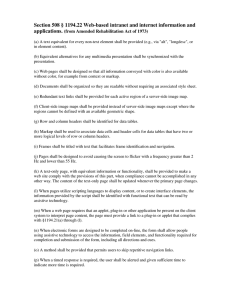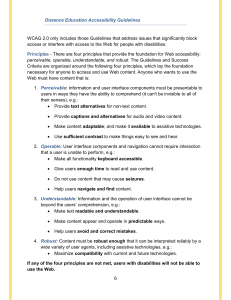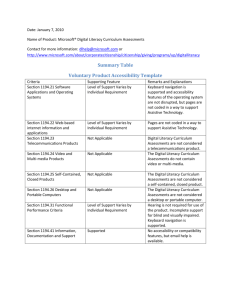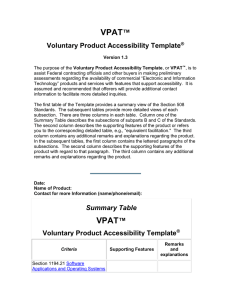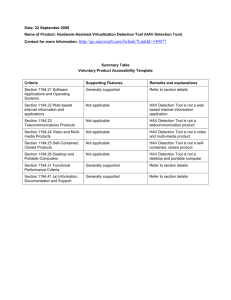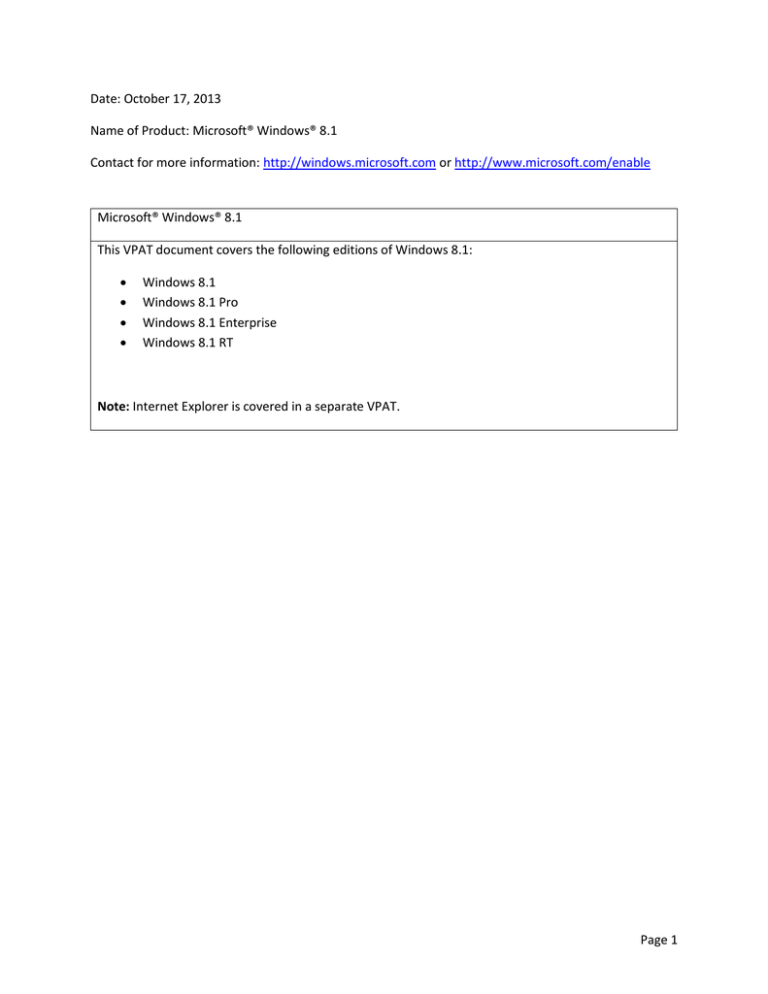
Date: October 17, 2013
Name of Product: Microsoft® Windows® 8.1
Contact for more information: http://windows.microsoft.com or http://www.microsoft.com/enable
Microsoft® Windows® 8.1
This VPAT document covers the following editions of Windows 8.1:
Windows 8.1
Windows 8.1 Pro
Windows 8.1 Enterprise
Windows 8.1 RT
Note: Internet Explorer is covered in a separate VPAT.
Page 1
Summary Table
Voluntary Product Accessibility Template
Page 2
Criteria
Section 1194.21
Software Applications
and Operating
Systems
Supporting Feature
Level of Support
Varies by Individual
Requirement
Remarks and Explanations
Windows 8.1 includes improvements of the assistive
technologies and accessibility. Following are some
examples:
1. Accessibility settings are consolidated into one
location within the PC Settings.
2. Narrator performance and editing
improvements.
3. Windows Automation Application Programming
Interface (API) has been updated to facilitate
assistive technology and information
technology interoperability.
Exceptions in individual features are noted in the main
VPAT.
Section 1194.22
Web-based internet
information and
applications
Section 1194.23
Telecommunications
Products
Section 1194.24
Video and Multimedia Products
Section 1194.25 SelfContained, Closed
Products
Section 1194.26
Desktop and Portable
Computers
Section 1194.31
Functional
Performance Criteria
Section 1194.41
Information,
Documentation and
Support
Not Applicable
Additional Windows accessibility features information
can be found on the Windows accessibility site.
Section not applicable to this product
Supported
Note that Internet Explorer is not considered a webbased internet information application.
Supported features are noted in the main VPAT.
Level of Support
Varies by Individual
Requirement
Supported features are noted in the main VPAT.
Windows Media Center no longer ships as a standard
feature.
Not Applicable
Windows Store Video and Music applications are also
offered for multimedia consumption. These
applications are covered in a separate VPAT.
Section not applicable to this product
Not Applicable
Section not applicable to this product
Level of Support
Varies by Individual
Requirement
Supported
Please refer to the VPAT Details
Please refer to the VPAT Details
Page 3
Page 4
Section 1194.21 Software Applications and Operating Systems - Detail
Voluntary Product Accessibility Template
Criteria
(a) When software is
designed to run on a
system that has a
keyboard, product
functions shall be
executable from a
keyboard where the
function itself or the
result of performing a
function can be
discerned textually.
Supporting Feature
Supported with
Exceptions
Remarks and Explanations
The vast majority of Windows 8.1 UI and applications
follow standard conventions for navigating around the
user interface from the keyboard.
Users can adjust the way Windows responds to mouse
or keyboard input so that key combinations are easier
to press, typing is easier, and inadvertent key presses
are ignored. For more information, see Make you PC
easier to use
Please note the following exceptions:
Drawing on the canvas of the Paint program is not
possible through keyboard-only navigation. The Color
Selection control in the Paint ribbon does not expose
programmatically its state or selected color.
In Explorer windows, the user can use the System
menu (ALT+SPACEBAR) to resize the window. However,
there is no keyboard method to resize individual panes
(such as the navigation pane or the preview pane) or
columns.
(b) Applications shall
not disrupt or disable
activated features of
other products that
are identified as
accessibility features,
where those features
are developed and
documented
according to industry
standards.
Applications also
shall not disrupt or
disable activated
features of any
operating system that
are identified as
accessibility features
where the application
Supported
Some Windows 8.1 UI and applications may not
provide consistent keyboard navigation on all UI
elements, but the ability for users to reach the UI
elements is still possible.
Accessibility features of the operating system are
uniformly applied. There are no known instances of
Windows 8.1 applications or individual features that
disable or disrupt the operation of the Windows
accessibility features.
Page 5
Criteria
Supporting Feature
Remarks and Explanations
Supported with
Exceptions
Programmatic and visual focus can be determined in all
themes and color schemes. For improved visual
appearance, the Ease of Access options within the PC
Settings allows the user to increase the thickness of the
focus rectangle and the cursor.
programming
interface for those
accessibility features
has been
documented by the
manufacturer of the
operating system and
is available to the
product developer.
(c) A well-defined onscreen indication of
the current focus
shall be provided that
moves among
interactive interface
elements as the input
focus changes. The
focus shall be
programmatically
exposed so that
Assistive Technology
can track focus and
focus changes.
The built-in magnifier provides the capabilities to track
the location of the currently focused item.
Please note the following exceptions:
On web page content authored by a web developer
may contain text that has been marked as nonselectable; however it may still indicate that it is
selectable in Narrator.
Focus indication is available when changing apps but
the exact location/state may not always remain the
same, if the user was in a middle of a page and
navigated away & back.
Accessibility data may be missing for complete usability
scenarios for:
1. Datalists and context menus within Internet
Explorer,
2. Websites that are using older doc modes,
3. F12 tools found in Internet Explorer for
developers, and
4. Bitlocker PIN entry
In web pages and apps, bulleted and numbered lists are
not accurately reflected through the in-box screen
reader.
(d) Sufficient
information about a
user interface
Supported with
Exceptions
While in verbose reading mode, annotations may be
reported at the beginning of the reading vs. in proper
order
Windows 8.1 includes enhancements to the Windows
UI Automation Application Programming Interface
(API), which will enable more powerful accessibility
Page 6
Criteria
element including the
identity, operation
and state of the
element shall be
available to Assistive
Technology. When an
image represents a
program element, the
information conveyed
by the image must
also be available in
text.
Supporting Feature
Remarks and Explanations
solutions to be created for the platform. Please refer
to the Windows Automation API: Overview site for
additional information.
User interface information is available
programmatically to assistive technology vendors
primarily through the User Interface Automation API.
Graphics are also accompanied by explanatory text
throughout the UI.
Please note the following exceptions:
In limited scenarios, UI elements in features and
applications may not consistently expose their state or
name, thus requiring the user to determine the control
type and desired behavior. For example, screen
readers will not read out the desktop background color
since the name is not available from the system.
In limited scenarios, UI elements in Windows features
and applications may have two names associated to it,
which may cause some initial ambiguity and multiple
navigation strokes.
Remote App programs do not pass programmatic data
across the network. However, users can leverage the
screen reader, as an example, on remote machines to
access information.
Narrator Touch users may not be able to manually
close, minimize, or maximize the desktop Internet
Explorer window. Users can close all tabs and use
gestures to move to the close button.
Some System tray Icons on the desktop are not
programmatically exposed and therefore cannot be
invoked by some assistive technologies.
Windows Media Player core function buttons (Play,
Shuffle, etc) are not programmatically exposed unless
you first mouse hover or use the keyboard to interact
with these controls.
Additional details see criteria 1194.21.c
Page 7
Criteria
Supporting Feature
Supported
Remarks and Explanations
Windows 8.1 consistently uses icons, graphics, status
indicators, and other visuals to give feedback to the
user and to indicate what actions can be taken.
(f) Textual information
shall be provided
through operating
system functions for
displaying text. The
minimum information
that shall be made
available is text
content, text input
caret location, and
text attributes.
Supported with
Exceptions
Textual information is available programmatically to
assistive technology vendors primarily through the User
Interface Automation API. See the UI Automation Text
Pattern documentation for more information.
(g) Applications shall
not override user
selected contrast and
color selections and
other individual
display attributes.
Supported with
Exceptions
(e) When bitmap
images are used to
identify controls,
status indicators, or
other programmatic
elements, the
meaning assigned to
those images shall be
consistent throughout
an application's
performance.
Please note the following exceptions:
In Windows Media Player, the dialog New Auto Playlist
does not textually expose certain details on configuring
criteria for the playlists.
Additional details see criteria 1194.21.c
Windows 8.1 provides and follows settings for
customizing specific color selections and display
attributes using the four inbox High Contrast themes.
Please note the following exceptions:
The Windows modern user interface provides one font
option rather than two (Serif and Sans Serif).
Customized font types are available on the desktop and
within applications.
In Windows Media Player, hover preview does not
work in high-contrast mode.
Due to their non-standard visual nature, not all the
games support the standard high-contrast modes.
Instead, they provide a mechanism for the user to
change their appearances and colors.
In some lower usage scenarios in Windows features,
there may be UI elements that do not show in high
contrast colors, even if the rest of the feature or
application is respecting the high contrast theme.
The high contrast themes that are set in the Ease of
Access in the PC Settings panel will roam with the
Page 8
Criteria
Supporting Feature
Remarks and Explanations
user’s log in. Sometimes this is perceived as preventing
high contrast from being turned off. Users can reapply
one of the non-high contrast themes in the Ease of
Access settings or the Personalization control panel
dialog to resolve the issue.
In some instances, the default desktop and lock screen
image may not meet the contrast ratios at install but
these can be changed.
Windows 8.1 consistently uses icons, graphics, status
indicators, and other visuals to give feedback to the
user and to indicate what actions can be taken.
Animation is not relied upon as the sole means of
communicating concepts in the user interface or
documentation.
(h) When animation is
displayed, the
information shall be
displayable in at least
one non-animated
presentation mode at
the option of the user.
Supported
(i) Color coding shall
not be used as the
only means of
conveying
information, indicating
an action, prompting
a response, or
distinguishing a visual
element.
Supported
Windows 8.1 consistently uses icons, graphics, status
indicators, and other visuals to give feedback to the
user and to indicate what actions can be taken. Color
coding is not relied upon as the sole means of
communicating concepts in the user interface or
documentation.
(j) When a product
permits a user to
adjust color and
contrast settings, a
variety of color
selections capable of
producing a range of
contrast levels shall
be provided.
Supported
Windows 8.1 provides four inbox High Contrast
themes, and the ability to customize colors within each
theme. This allows users to adjust background, text
(button, selected, disabled, and normal text) color and
background, and control colors to the combination that
works best for them.
(k) Software shall not
use flashing or
blinking text, objects,
or other elements
having a flash or blink
frequency greater
than 2 Hz and lower
than 55 Hz.
Supported with
Exceptions
Flashing and blinking in Windows 8.1 visual surfaces
respect the prescribed frequency range.
(l) When electronic
forms are used, the
form shall allow
people using
Assistive Technology
to access the
information, field
elements, and
Supported with
Exceptions
As in prior releases of Windows, the Ease of Access
center allows the user to change the rate of blinking of
the system caret.
Windows 8 introduced an inbox Reader application for
PDF and XPS files, which can be used with Windows 8
inbox assistive technology features, as well as 3rd party
assistive technology products (using exposed
programmatic data).
Page 9
Criteria
functionality required
for completion and
submission of the
form, including all
directions and cues.
Supporting Feature
Remarks and Explanations
Internet Explorer supports validation of forms data on
web sites. However, accessibility data for the validation
messages is missing. There are cues that the form
submission did not complete and the developers can
workaround.
Page 10
Section 1194.22 Web-based Internet information and applications – Detail
Voluntary Product Accessibility Template
Criteria
(a) A text equivalent for every non-text
element shall be provided (e.g., via
"alt", "longdesc", or in element content).
Supporting Feature
Not Applicable
(b) Equivalent alternatives for any
multimedia presentation shall be
synchronized with the presentation.
Not Applicable
(c) Web pages shall be designed so
that all information conveyed with color
is also available without color, for
example from context or markup.
Not Applicable
(d) Documents shall be organized so
they are readable without requiring an
associated style sheet.
Not Applicable
(e) Redundant text links shall be
provided for each active region of a
server-side image map.
Not Applicable
(f) Client-side image maps shall be
provided instead of server-side image
maps except where the regions cannot
be defined with an available geometric
shape.
Not Applicable
(g) Row and column headers shall be
identified for data tables.
Not Applicable
(h) Markup shall be used to associate
data cells and header cells for data
tables that have two or more logical
levels of row or column headers.
Not Applicable
(i) Frames shall be titled with text that
facilitates frame identification and
navigation
Not Applicable
(j) Pages shall be designed to avoid
causing the screen to flicker with a
frequency greater than 2 Hz and lower
than 55 Hz.
Not Applicable
(k) A text-only page, with equivalent
information or functionality, shall be
provided to make a web site comply
with the provisions of this part, when
compliance cannot be accomplished in
any other way. The content of the textonly page shall be updated whenever
the primary page changes.
Not Applicable
(l) When pages utilize scripting
languages to display content, or to
Not Applicable
Remarks and Explanations
Internet Explorer is not considered a
web-based internet information
application.
Page 11
Criteria
Supporting Feature
Remarks and Explanations
create interface elements, the
information provided by the script shall
be identified with functional text that
can be read by Assistive Technology.
(m) When a web page requires that an
applet, plug-in or other application be
present on the client system to interpret
page content, the page must provide a
link to a plug-in or applet that complies
with §1194.21(a) through (l).
Not Applicable
(n) When electronic forms are designed
to be completed on-line, the form shall
allow people using Assistive
Technology to access the information,
field elements, and functionality
required for completion and submission
of the form, including all directions and
cues.
Not Applicable
(o) A method shall be provided that
permits users to skip repetitive
navigation links.
Not Applicable
(p) When a timed response is required,
the user shall be alerted and given
sufficient time to indicate more time is
required.
Not Applicable
Page 12
Section 1194.23 Telecommunications Products – Detail
Voluntary Product Accessibility Template
Criteria
Supporting Feature
Remarks and Explanations
(a) Telecommunications products or
systems which provide a function
allowing voice communication and
which do not themselves provide a TTY
functionality shall provide a standard
non-acoustic connection point for
TTYs. Microphones shall be capable of
being turned on and off to allow the
user to intermix speech with TTY use.
Not Applicable
Support is dependent on
implementation by separate product.
(b) Telecommunications products
which include voice communication
functionality shall support all commonly
used cross-manufacturer nonproprietary standard TTY signal
protocols.
Not Applicable
Support is dependent on
implementation by separate product.
(c) Voice mail, auto-attendant, and
interactive voice response
telecommunications systems shall be
usable by TTY users with their TTYs.
Not Applicable
Support is dependent on
implementation by separate product.
(d) Voice mail, messaging, autoattendant, and interactive voice
response telecommunications systems
that require a response from a user
within a time interval, shall give an alert
when the time interval is about to run
out, and shall provide sufficient time for
the user to indicate more time is
required.
Not Applicable
Support is dependent on
implementation by separate product.
(e) Where provided, caller identification
and similar telecommunications
functions shall also be available for
users of TTYs, and for users who
cannot see displays.
Not Applicable
Support is dependent on
implementation by separate product.
(f) For transmitted voice signals,
telecommunications products shall
provide a gain adjustable up to a
minimum of 20 dB. For incremental
volume control, at least one
intermediate step of 12 dB of gain shall
be provided.
Not Applicable
Support is dependent on
implementation by separate product.
(g) If the telecommunications product
allows a user to adjust the receive
volume, a function shall be provided to
automatically reset the volume to the
default level after every use.
Not Applicable
Support is dependent on
implementation by separate product.
Page 13
Criteria
Supporting Feature
Remarks and Explanations
(h) Where a telecommunications
product delivers output by an audio
transducer which is normally held up to
the ear, a means for effective magnetic
wireless coupling to hearing
technologies shall be provided.
Not Applicable
Support is dependent on
implementation by separate product.
(i) Interference to hearing technologies
(including hearing aids, cochlear
implants, and assistive listening
devices) shall be reduced to the lowest
possible level that allows a user of
hearing technologies to utilize the
telecommunications product.
Not Applicable
Support is dependent on
implementation by separate product.
(j) Products that transmit or conduct
information or communication, shall
pass through cross-manufacturer, nonproprietary, industry-standard codes,
translation protocols, formats or other
information necessary to provide the
information or communication in a
usable format. Technologies which use
encoding, signal compression, format
transformation, or similar techniques
shall not remove information needed
for access or shall restore it upon
delivery.
Supported
Windows Media Player meets this
requirement.
(k)(1) Products which have
mechanically operated controls or keys
shall comply with the following:
Controls and Keys shall be tactilely
discernible without activating the
controls or keys.
Not Applicable
Support is dependent on
implementation by separate product.
(k)(2) Products which have
mechanically operated controls or keys
shall comply with the following:
Controls and Keys shall be operable
with one hand and shall not require
tight grasping, pinching, twisting of the
wrist. The force required to activate
controls and keys shall be 5 lbs.
(22.2N) maximum.
Not Applicable
Support is dependent on
implementation by separate product.
(k)(3) Products which have
mechanically operated controls or keys
shall comply with the following: If key
repeat is supported, the delay before
repeat shall be adjustable to at least 2
seconds. Key repeat rate shall be
adjustable to 2 seconds per character.
Not Applicable
Support is dependent on
implementation by separate product.
(k)(4) Products which have
mechanically operated controls or keys
shall comply with the following: The
Not Applicable
Support is dependent on
implementation by separate product.
Page 14
Criteria
Supporting Feature
Remarks and Explanations
status of all locking or toggle controls or
keys shall be visually discernible, and
discernible either through touch or
sound.
Page 15
Section 1194.24 Video and Multi-media Products – Detail
Voluntary Product Accessibility Template
Criteria
Supporting Feature
Remarks and Explanations
(a) All analog television displays 13
inches and larger, and computer
equipment that includes analog
television receiver or display circuitry,
shall be equipped with caption decoder
circuitry which appropriately receives,
decodes, and displays closed captions
from broadcast, cable, videotape, and
DVD signals. As soon as practicable,
but not later than July 1, 2002,
widescreen digital television (DTV)
displays measuring at least 7.8 inches
vertically, DTV sets with conventional
displays measuring at least 13 inches
vertically, and stand-alone DTV tuners,
whether or not they are marketed with
display screens, and computer
equipment that includes DTV receiver
or display circuitry, shall be equipped
with caption decoder circuitry which
appropriately receives, decodes, and
displays closed captions from
broadcast, cable, videotape, and DVD
signals.
Not Applicable
Support is dependent on
implementation by separate product.
(b) Television tuners, including tuner
cards for use in computers, shall be
equipped with secondary audio
program playback circuitry.
Not Applicable
Support is dependent on
implementation by separate product.
Supported
All audio/visual training included in
Windows 8.1 is also available (either
in the box or through a separate
request) in alternative textual
formats.
Note that not all videos which
document functionality contain
captioning however videos are not
the only medium through which
information is presented.
All audio/visual training included in
Windows 8.1 is also available (either
in the box or through a separate
request) in alternative textual
formats.
(c) All training and informational video
and multimedia productions which
support the agency's mission,
regardless of format, that contain
speech or other audio information
necessary for the comprehension of the
content, shall be open or closed
captioned.
(d) All training and informational video
and multimedia productions which
support the agency's mission,
regardless of format, that contain visual
information necessary for the
comprehension of the content, shall be
audio described.
Supported with
Exceptions
Please note the following exception:
Page 16
Supporting Feature
Criteria
Supported
(e) Display or presentation of alternate
text presentation or audio descriptions
shall be user-selectable unless
permanent.
Remarks and Explanations
Between Windows setup and first
logon, a brief tutorial illustrates how
to use the user interface through
animations and text. Screen reader
users won't hear an exact audio
description of the animations and
text in the tutorial, but will hear a
message that their PC is being set up
and not to turn off their PC. This
ensures visually impaired users know
that the system is busy and not to
disrupt the setup process. Users can
obtain tutorials on how to use the
Windows 8.1 user interface through
training available online at
http://windows.microsoft.com/enUS/windows-8/hear-text-read-aloudwith-narrator
Windows Media Player allows for
user control of display of alternate
text or audio description, provided
such is available with the media
being viewed.
Internet Explorer supports captions
in HTML5 and Flash content.
Section 1194.25 Self-Contained, Closed Products – Detail
Voluntary Product Accessibility Template
Criteria
Supporting Feature
Remarks and Explanations
(a) Self contained products shall be
usable by people with disabilities
without requiring an end-user to attach
Assistive Technology to the product.
Personal headsets for private listening
are not Assistive Technology.
Not Applicable
Support is dependent on
implementation by separate product.
(b) When a timed response is required,
the user shall be alerted and given
sufficient time to indicate more time is
required.
Not Applicable
Support is dependent on
implementation by separate product.
(c) Where a product utilizes
touchscreens or contact-sensitive
controls, an input method shall be
provided that complies with §1194.23
(k) (1) through (4).
Not Applicable
Support is dependent on
implementation by separate product.
Page 17
Criteria
Supporting Feature
Remarks and Explanations
(d) When biometric forms of user
identification or control are used, an
alternative form of identification or
activation, which does not require the
user to possess particular biological
characteristics, shall also be provided.
Not Applicable
Support is dependent on
implementation by separate product.
(e) When products provide auditory
output, the audio signal shall be
provided at a standard signal level
through an industry standard connector
that will allow for private listening. The
product must provide the ability to
interrupt, pause, and restart the audio
at anytime.
Not Applicable
Support is dependent on
implementation by separate product.
(f) When products deliver voice output
in a public area, incremental volume
control shall be provided with output
amplification up to a level of at least 65
dB. Where the ambient noise level of
the environment is above 45 dB, a
volume gain of at least 20 dB above the
ambient level shall be user selectable.
A function shall be provided to
automatically reset the volume to the
default level after every use.
Not Applicable
Support is dependent on
implementation by separate product.
(g) Color coding shall not be used as
the only means of conveying
information, indicating an action,
prompting a response, or distinguishing
a visual element.
Not Applicable
Support is dependent on
implementation by separate product.
(h) When a product permits a user to
adjust color and contrast settings, a
range of color selections capable of
producing a variety of contrast levels
shall be provided.
Not Applicable
Support is dependent on
implementation by separate product.
(i) Products shall be designed to avoid
causing the screen to flicker with a
frequency greater than 2 Hz and lower
than 55 Hz.
Not Applicable
Support is dependent on
implementation by separate product.
(j) (1) Products which are freestanding,
non-portable, and intended to be used
in one location and which have
operable controls shall comply with the
following: The position of any operable
control shall be determined with
respect to a vertical plane, which is 48
inches in length, centered on the
operable control, and at the maximum
protrusion of the product within the 48
inch length on products which are
freestanding, non-portable, and
Not Applicable
Support is dependent on
implementation by separate product.
Page 18
Supporting Feature
Remarks and Explanations
(j)(2) Products which are freestanding,
non-portable, and intended to be used
in one location and which have
operable controls shall comply with the
following: Where any operable control
is 10 inches or less behind the
reference plane, the height shall be 54
inches maximum and 15 inches
minimum above the floor.
Not Applicable
Support is dependent on
implementation by separate product.
(j)(3) Products which are freestanding,
non-portable, and intended to be used
in one location and which have
operable controls shall comply with the
following: Where any operable control
is more than 10 inches and not more
than 24 inches behind the reference
plane, the height shall be 46 inches
maximum and 15 inches minimum
above the floor.
Not Applicable
Support is dependent on
implementation by separate product.
(j)(4) Products which are freestanding,
non-portable, and intended to be used
in one location and which have
operable controls shall comply with the
following: Operable controls shall not
be more than 24 inches behind the
reference plane.
Not Applicable
Support is dependent on
implementation by separate product.
Criteria
intended to be used in one location and
which have operable controls.
Section 1194.26 Desktop and Portable Computers – Detail
Voluntary Product Accessibility Template
Criteria
Supporting Feature
Remarks and Explanations
(a) All mechanically operated controls
and keys shall comply with §1194.23
(k) (1) through (4).
Not Applicable
Support is dependent on
implementation by separate product.
Not Applicable
Support is dependent on
implementation by separate product.
(b) If a product utilizes touchscreens or
touch-operated controls, an input
method shall be provided that complies
with §1194.23 (k) (1) through (4).
(c) When biometric forms of user
identification or control are used, an
alternative form of identification or
Not Applicable
Windows 8.1 offers multi-touch
functionality for devices that support
multi-touch. All operations that can
be done via multi-touch can also be
performed via other input
mechanisms.
Support is dependent on
implementation by separate product.
Page 19
Criteria
Supporting Feature
Remarks and Explanations
Not Applicable
Support is dependent on
implementation by separate product.
activation, which does not require the
user to possess particular biological
characteristics, shall also be provided.
(d) Where provided, at least one of
each type of expansion slots, ports and
connectors shall comply with publicly
available industry standards
Page 20
Section 1194.31 Functional Performance Criteria – Detail
Voluntary Product Accessibility Template
Criteria
Supporting Feature
Remarks and Explanations
(a) At least one mode
of operation and
information retrieval
that does not require
user vision shall be
provided, or support
for Assistive
Technology used by
people who are blind
or visually impaired
shall be provided.
Supported with
Exceptions
The vast majority of features and scenarios in
Windows 8.1 can be used through assistive
technologies such as screen-readers and therefore do
not require user vision.
Windows 8.1 ships with a screen reader called
Narrator, which will read aloud elements and text
that appear on the screen. Narrator supports touch,
keyboard, and mouse input, and can be used with
Windows 8.1 UI, features and applications.
Windows also has settings for providing audio
descriptions for videos and controlling how dialog
boxes appear. For more information, see Use the
computer without a display.
Windows 8.1 ships with a Magnifier that supports
touch input, in addition to the previous modes of
operation – full-screen, lens, and docked mode – as
well as color inverting. Full-screen magnification
when a high contrast theme is active is supported.
Note the minor exception that Magnifier docked
mode is not supported for Windows 8.1 UI and
applications, but can still be used for the traditional
Windows desktop and applications.
Many other programs and hardware are compatible
with Windows and available to help individuals who
are blind, including screen readers, Braille output
devices, and other useful products. For more
information, go to the Microsoft Accessibility
website.
(b) At least one mode
of operation and
information retrieval
Supported with
Exceptions
The limitations listed in sections 1194.21 may present
difficulties for some users depending on their choice
of and skills with specific assistive technologies.
Additionally, Internet Explorer provides support for
assistive technologies through Microsoft Active
Accessibility and UI Automation for assistive
technologies to leverage the output.
Windows 8.1 provides features for improving the
visibility of user interfaces, such as a built-in
Magnifier, High Contrast modes, High-DPI
Page 21
Criteria
Supporting Feature
Remarks and Explanations
adjustments and screen resolutions (if supported by
the hardware), and additional features from Ease of
Access settings for changing the size of the cursor,
changing the thickness of the focus rectangle, and
others.
that does not require
visual acuity greater
than 20/70 shall be
provided in audio and
enlarged print output
working together or
independently, or
support for Assistive
Technology used by
people who are
visually impaired shall
be provided.
Windows 8.1 introduces a new setting for UI and
applications in the Display settings that allows for the
size of the app, text, and other items on screen to
change (replacing the Windows 8 setting Make
Everything Bigger). There are also more options for
resolution settings within the Display setting. These
two options provide users with the ability to scale an
application to the next highest resolution.
Note more options are available within the desktop
Control Panel Appearance and Personalization
Display settings. The user can select “Let me choose
one scaling level for all my displays” which will
provide up to 150% options and a link to “customize
sizing options” which will scale up to 500%.
The need for even larger text can be satisfied by the
built-in Magnifier or other 3rd party assistive
technologies.
(c) At least one mode
of operation and
information retrieval
that does not require
user hearing shall be
provided, or support
for Assistive
Technology used by
people who are deaf
or hard of hearing
shall be provided
Supported
(d) Where audio
information is
important for the use
of a product, at least
one mode of operation
and information
Supported
The limitations listed in sections 1194.21 may present
difficulties for some users depending on their choice
of and skills with specific assistive technologies.
In Windows 8.1, all sounds can be turned off without
affecting the use of the operating system. Visual
notifications or the Sound Sentry feature could alert
the user to important information and tell them if
sound events have occurred.
Windows can replace two types of audio information
with visual equivalents. Users can replace system
sounds with visual alerts and can display text
captions for spoken dialog in multimedia programs.
For more information, see Use text or visual
alternatives to sounds.
Windows 8.1 consistently uses icons, graphics, status
indicators and other visuals to give feedback to the
user and to indicate what actions can be taken next.
Sound is not relied upon as the sole means of
Page 22
Criteria
Supporting Feature
Remarks and Explanations
communicating concepts in the user interface or
documentation.
retrieval shall be
provided in an
enhanced auditory
fashion, or support for
assistive hearing
devices shall be
provided.
(e) At least one mode
of operation and
information retrieval
that does not require
user speech shall be
provided, or support
for Assistive
Technology used by
people with disabilities
shall be provided.
Supported
(f) At least one mode
of operation and
information retrieval
that does not require
fine motor control or
simultaneous actions
and that is operable
with limited reach and
strength shall be
provided.
Supported
Windows can replace two types of audio information
with visual equivalents. Users can replace system
sounds with visual alerts and you can display text
captions for spoken dialog in multimedia programs.
For more information, see Use text or visual
alternatives to sounds.
While Windows 8.1 provides support for speech
input through the Windows Speech Recognition
feature, speech is not required in order to use any
feature.
Windows 8.1 includes an On-Screen Keyboard that
user can use to type. The On-Screen Keyboard
provides options to fade, docked, and navigation
mode settings - allowing users to interact with
Windows 8.1 UI and applications more effectively.
Users can also use Windows Speech
Recognition to control the computer with voice
commands and dictate text into programs. For more
information, see Using Speech Recognition.
The limitations listed in sections 1194.21 may present
difficulties for some users depending on their choice
of and skills with specific assistive technologies.
Page 23
Section 1194.41 Information, Documentation and Support – Detail
Voluntary Product Accessibility Template
Criteria
Supporting Feature
Remarks and Explanations
(a) Product support documentation
provided to end-users shall be made
available in alternate formats upon
request, at no additional charge
Supported
Online documentation is available at
http://windows.microsoft.com/enUS/windows/help
(b) End-users shall have access to a
description of the accessibility and
compatibility features of products in
alternate formats or alternate methods
upon request, at no additional charge.
Supported
Microsoft can produce alternative
format of documentation for
customer upon request.
Supported
The Microsoft Product Support
Services Help Desk is familiar with
such features as keyboard access and
other options important to people
with disabilities.
(c) Support services for products shall
accommodate the communication
needs of end-users with disabilities.
Microsoft offers a teletypewriter
(TTY) service for customers who are
hearing impaired. For assistance in
the United States, contact Microsoft
Technical Support on a TTY at 1-800892-5234. This service is available
Monday through Friday 6:00 A.M. to
6:00 P.M. PST.
For information on additional
support services, visit the Microsoft
Accessibility Web site at
http://www.microsoft.com/enable/
Click here to enter text.
This document is for informational purposes only. MICROSOFT MAKES NO WARRANTIES, EXPRESS
OR IMPLIED, IN THIS DOCUMENT.
© 2012 Microsoft Corporation. All rights reserved. The names of actual companies and products
mentioned herein may be the trademarks of their respective owners. The information contained in this
document represents the current view of Microsoft Corporation on the issues discussed as of the date of
publication. Microsoft cannot guarantee the accuracy of any information presented after the date of
publication.
Revised October 8, 2013
Microsoft regularly updates its websites and provides new information about the accessibility of products
as that information becomes available.
Page 24

